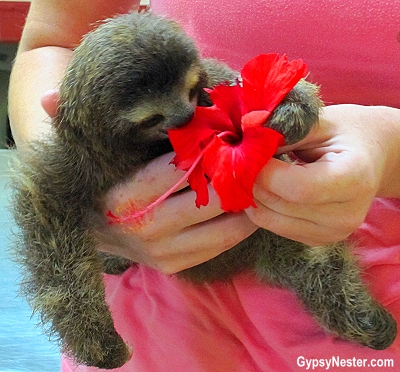 While exploring the area around Costa Rica’s Manuel Antonio National Park, we noticed a rope strung across the road.
While exploring the area around Costa Rica’s Manuel Antonio National Park, we noticed a rope strung across the road.
Curious, we started to pay closer attention and found that they were all over the place, tons of them.
We wondered what was up, and the answer was a bit surprising, most of the ropes can be traced back to a couple of nine-year-old girls. What? That’s right, two kids with a big idea had a huge impact on the ecosystem of the region.
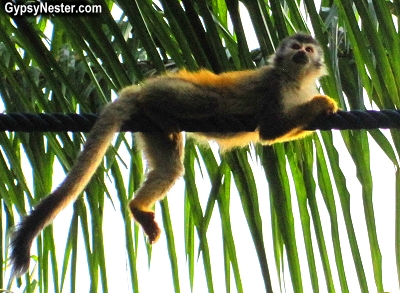
Let’s go back to the beginning and explain how we learned about this.
A Facebook friend suggested that while we were in Costa Rica we should check out Kids Saving the Rainforest if we had the chance and, chance would have it, we would.
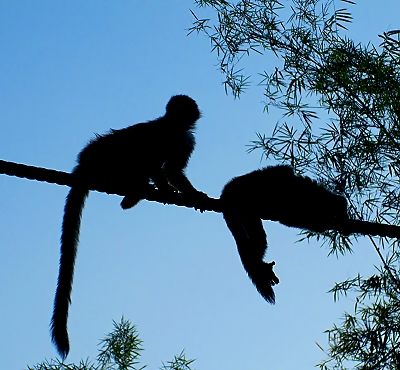
We just happened to be staying near the Hotel Mono Azul, Blue Monkey to us gringos, which is the official meeting spot for tours of the Kids Saving the Rainforest Wildlife Rescue Center and Sanctuary.
A short ride into the forest took us to the Blue Banyan Inn, which provides a home to the sanctuary and lodging for volunteers. As we chatted with a few of the longtime workers, we got the scoop on the remarkable story of how things all came together.
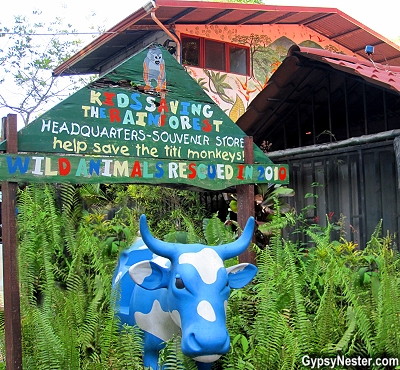
Back in 1999, two friends, Janine Licare and Aislin Livingstone, got the idea to raise money for a project to “save the rainforest,” so they set about selling papier-mâché bottles and painted rock paperweights from a “crazy cute” roadside stand.
They were shocked to discover that the money they raised was not enough to buy and save the entire forest, they were only nine after all, so they started small by making monkey bridges.
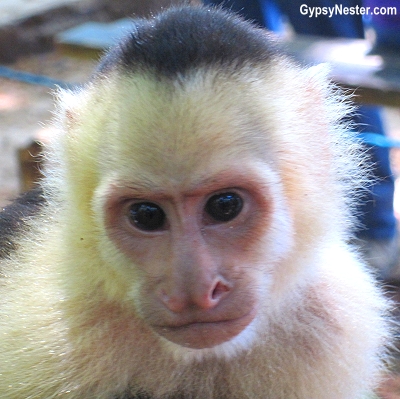
So that’s what those ropes across the roads are! They provide a safe way for monkeys to get across the road.
Much better than power lines, which have a nasty tendency to electrocute a crossing primate from time to time.
Hearing their story had us excited to see what became of the project after fifteen years, so we headed into the forest to check it out.
Quite an operation has grown from those humble beginnings, placing bridges (over one hundred and thirty so far) in areas where monkeys often travel is still a big part of it, and those efforts have paid off big time.
Since beginning the program, the population of the once endangered squirrel monkey has more than doubled.
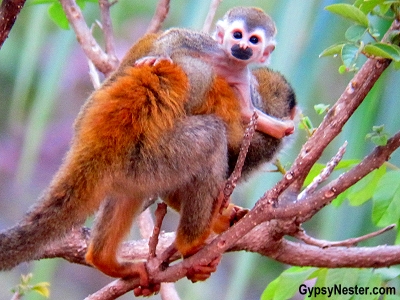
The bridges were just the beginning; they have worked with Costa Rica’s National Park Service and schools to plant nearly seven thousand rainforest trees, and the Wildlife Rescue Center and Sanctuary is now in full swing.
To date they have saved hundreds of monkeys, also in addition to marmosets, tamarins, kinkajou, sloths, porcupines, parrots, and parakeets.
Our first stop was the hospital, where an orphaned three-toed sloth baby was getting a snack of hibiscus flowers.
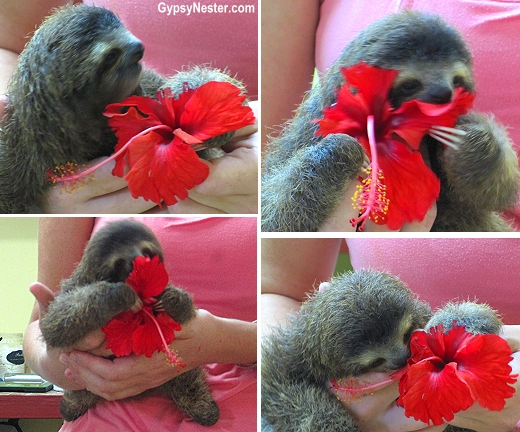
If you think that‘s cute, you have to watch her in action:
Injured and orphaned animals are brought in from all around the area, treated, and ideally released back into the wild.

It is very similar to the highly successful system we saw in Australia at the Koala Sanctuary and the Australia Zoo.
As with those facilities, if it is determined that the animals are unlikely to fare well in the wild, or if they are not indigenous to the area, then they are kept on site and looked after for the rest of their lives.
Because of this we got to see a few species that we otherwise never would have encountered in Costa Rica.
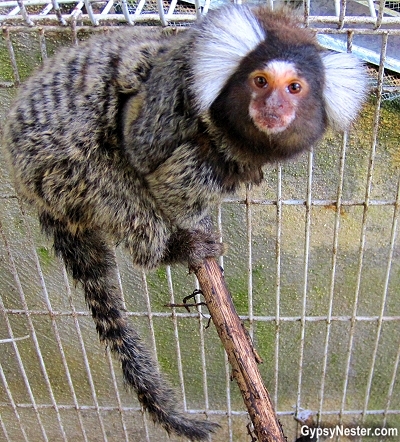
One of those was a tiny member of the primate family, the common marmoset.
They are well represented in the sanctuary because they have adapted very successfully to breeding while in captivity.
The attempts to keep them separated by sex have proven to be less than completely effective. From the looks of the little guys, we’d say it would be a good idea to never feed them after midnight, or let them get wet either.
Native to Brazil, these gremlins …oops… marmosets, were rescued from a scientific research facility, or at least the first generation of them was. Most of the other non-indigenous species were pets that either escaped their owners or had been abandoned.
But the bulk of the sanctuary’s residents are native species that will one day get to return to the rainforest.
While the center regularly cares for all of Costa Rica’s types of monkeys — capuchin, howler, squirrel, and Geoffroy’s spider monkeys – only three of the four were being tended to on the day of our visit.
There were no howler monkeys, which was good news in that it meant none were currently sick or injured. We had seen some in the wild so we didn’t feel like we were missing out too much, and there were plenty of other monkeys to see.

A few days earlier, on the grounds of The Parador Resort, we had encountered a group of Central American squirrel monkeys.
Now we had a chance to get even closer, and perhaps interact a bit with the rambunctious little rascals.
Their huge enclosure was specially designed so that visitors can pass right through the troop as they scramble alongside and overhead.
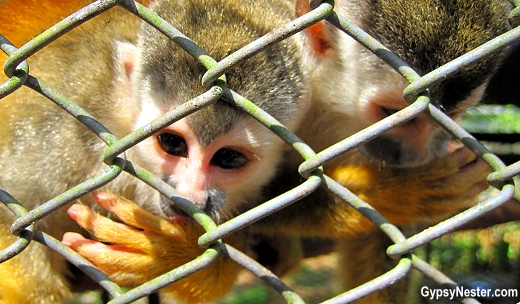
 They seemed every bit as curious about us as we were about them, often stopping to examine us through the fence.
They seemed every bit as curious about us as we were about them, often stopping to examine us through the fence.
On several occasions they reached through the fence, usually in attempts to snatch a hat, button off of a shirt, or camera.
Were they just curious, or out to snap a few monkey selfies?
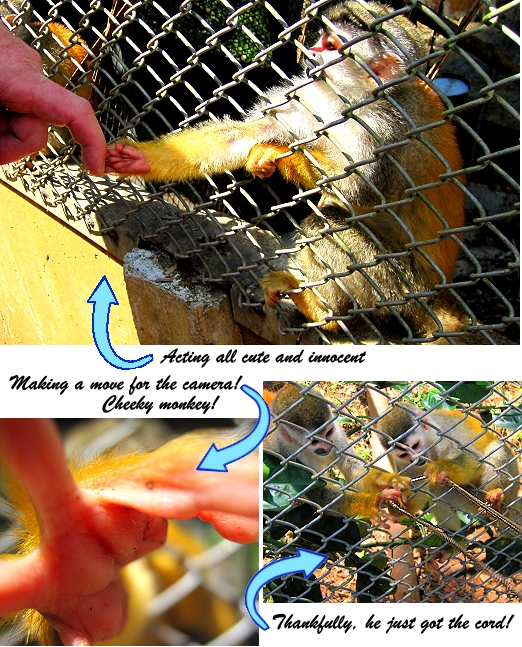
Note: The photo of the human finger is of a shelter volunteer and visitors are not allowed to touch or handle the animals at any time.
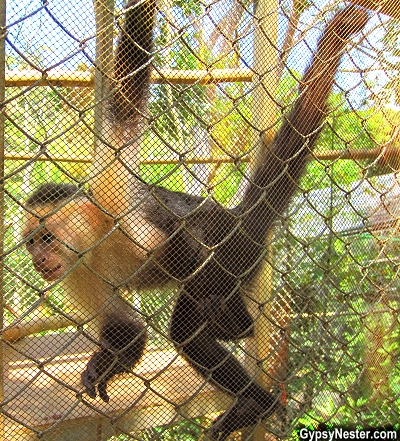
A smaller group of white-faced capuchins began to get a little boisterous when they heard the racket the squirrels were kicking up, so we headed down the path to see what they were up to.
These seem to be the most common primate in Costa Rica, we had seen them almost every day.
In fact, we had been lucky enough to see all of Costa Rica’s indigenous monkeys in the wild, except the rare Geoffroy’s spider monkey, so we were most excited to meet him.
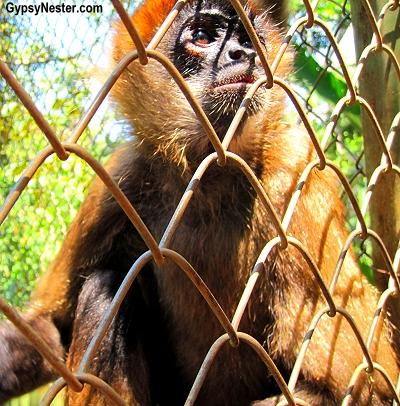
Even in captivity it was a treat for us to see the Geoffroy’s spider monkeys because, not only are there very few, they generally do not live in the area around Manuel Antonio National Park.
They are listed as endangered by the International Union for Conservation of Nature.
Unfortunately the pair here at the sanctuary will not be released back into the wild because the female is too old, and the male was a pet and is not suited for the wild life.
He demonstrated that point when he escaped one time, instead of heading out into the forest, he made a beeline to a nearby home and made himself comfortable in the living room.
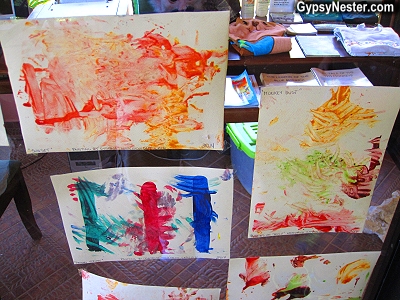
These primates are all very intelligent creatures, so the staff has come up with creative activities to keep them entertained.
A favorite for both the volunteers and the monkeys is painting.
Blank pages with fruit and vegetable dyes are placed where the animals can get to them and let their inner Picasso out. The results are quite interesting, very avant-garde.
We got to check out several of the works in the gift area as we were leaving. Yes, even here we exited through the gift shop.
David & Veronica, GypsyNester.com
Find out more about Kids Saving the Rainforest – click here to visit their website.
DELVE DEEPER:
See where we stayed: Parador Resort and Spa
Find out more about beautiful Manuel Antonio National Park
Visit the animals of Costa Rica after dark!



Thanks!
I had to look twice at that picture of the girl in the pink dress! Although, yes, they are doing a marvelous job
What a wonderful use of girl power:) Thanks for posting this wonderful story.
Hadn’t thought of that, but this truly was girl power! Our pleasure.
I’m about to head on a tour of Central America … I’m gonna have to stop by this place now!
Definitely should, not only is it very cool, but they are doing great work too.
What a fabulous post – you taught me so much about these animals of Costa Rica. And great photos!
Thanks Pamela!
Such a nice story and beautiful photos!
Thanks Anda!
Your pictures and site are amazing! So impressive!! We are all so grateful to you for the videos and pics, not to mention the text you wrote about Kids Saving the Rainforest. We feel very honored to have had you come to our sanctuary!
Keep up your great work, I am now going to follow your writings!
Thanks so much Jennifer – we’re glad you feel we gave Kids Saving the Rainforest the credit it deserves – makes our day! 🙂 Thank you for doing all that you do to help out the animals of Costa Rica – it’s a special place to visit because of folks like you!
I love hearing stories like this. It’s so inspiring.
Isn’t it great? 🙂 🙂